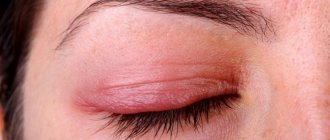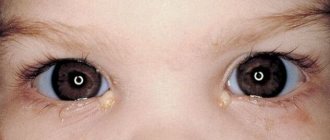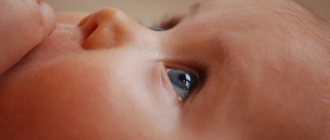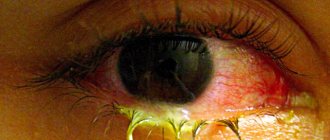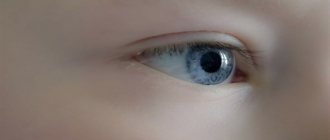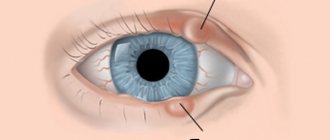One of the manifestations of an increased reaction of the body to certain antigens is allergic conjunctivitis in children. Pathology appears at any age, but most often develops in preschoolers.
Signs of pathology bring great discomfort to the child. Apart from the visible inconvenience, the symptoms are quite painless.
Therefore, it is important to promptly identify the first signs of atypical conjunctivitis in a child and begin its treatment.
Causes of allergic conjunctivitis in a child
For all types of allergic conjunctivitis, the primary cause is direct contact with the allergen. There are a large number of them, and each form of conjunctivitis has its own allergen.
- For year-round conjunctivitis, provoking causes may be: chemical compounds from household chemicals;
- particles of pet fur (cats, dogs, domesticated rodents);
- feathers and down of representatives of birds (parrots, chickens, geese and ducks);
- dust mites found in house dust (on the surface of furniture, carpets);
- mushroom mycelium (grows on walls, in rooms with high air humidity).
- ambrosia;
- contact lenses, and solutions for their storage;
- paints and varnishes;
- citrus fruits;
What it is?
Atopic conjunctivitis is an inflammation of the conjunctiva of the eye that is of allergic origin. In addition to the symptoms characteristic of all conjunctivitis, the disease makes itself felt by swelling of the larynx and skin rash. Usually it develops rapidly and requires complex, timely treatment.
For the development of the disease, a combination of several conditions is necessary, including disruption of the autoimmune system, predisposition and external factors.
The disease often accompanies dermatitis, asthma, urticaria and other immunological reactions. The clinical picture of the pathology is pronounced. A bilateral inflammatory process occurs, the eyelids and skin begin to peel off, itching and swelling appear.
Expert opinion
Ermolaeva Tatyana Borisovna
Ophthalmologist of the highest category, Candidate of Medical Sciences
Atopic eye inflammation is a favorable environment for secondary infection.
Classification of allergic conjunctivitis
The course of this disease directly depends on the cause that causes this pathological condition.
It is customary to distinguish the following types of conjunctivitis of allergic etiology:
- Spring Qatar . A type of allergic conjunctivitis, which is characterized by a long course, with periodic exacerbations associated with increased exposure to direct sunlight. The pathology most often occurs in boys under 12 years of age. Accompanied by symptoms of papillary growths on the mucous membrane of the eye. There is a great danger if the pathological process spreads to the cornea. In this case, partial loss of vision may occur.
- Seasonal hay fever . The most common type of allergic pathology. It develops from the beginning of spring and lasts until the end of autumn. The irritant is pollen from plants, shrubs, and trees. It manifests itself not only as inflammatory processes on the mucous membrane of the eye, but in parallel, damage can occur to: superficial skin;
- dermatitis;
- hives;
- respiratory tract and nasal passages;
- rhinopathy;
- bronchitis with an asthmatic component;
- sinusitis;
- laryngitis;
- digestive organs;
- gastritis;
- enteritis.
- bacterial.
Allergic conjunctivitis occurs with varying degrees of intensity. Its clinical picture depends on this.
There are three main variants of the course of the disease:
- Spicy . Characterized by the presence of a vivid clinical picture, with severe symptoms;
- Subacute . Another name is latent or hidden. The name speaks for itself. Symptoms are mild or absent;
- Chronic . A long course is accompanied by attenuation of the disease and the appearance of sudden relapses.
Conjunctivitis of allergic etiology is divided into diseases according to the degree of manifestation:
- With seasonal flow . The pathological process starts at any time of the year, because the allergen is close to the person;
- Associated with seasonal dependence . Most often this is spring hay fever. The appearance of pollen is associated with a certain period of the year, which causes the presence of allergies;
- Contact type . The disease manifests itself only upon contact with an allergen. In children, in most cases this occurs after using medications (ointments, eye drops, the wrong type of soap).
Types of disease
Depending on what triggered the reaction, there are several forms of the disease:
- Hay fever (seasonal allergic rhinoconjunctivitis, sometimes called hay fever) occurs during the flowering of some plants.
- Spring conjunctivitis, or spring catarrh, is observed mainly in boys 5–12 years old in the spring months, when there is a lot of sunlight. This type is chronic, long-term and has 3 forms:
- conjunctival;
- limbal;
- mixed.
- The medicinal type is associated with the use of certain drugs.
- Phlyctenulous (scrofulous) keratoconjunctivitis is of a tuberculous-allergic nature and occurs most often in children under 3 years of age, including infants.
- Large-papillary (large-papillary, hyperpapillary) type of disease occurs when the eye comes into constant contact with a foreign body.
- The infectious-allergic type occurs due to increased sensitivity of the body to exotoxins produced by microbes: bacteria, fungi, viruses. In this case, the pathogen itself is not present in the tissues of the eye.
Video - what happens with allergic conjunctivitis
Symptoms
Allergic conjunctivitis is characterized by the presence of primary and secondary symptoms, and the severity of the clinical picture depends on the amount of the allergen and the duration of its exposure. The first signs of the disease may appear 1 hour after contact with the irritant.
The clinical picture usually develops against the background of the following symptoms:
- Increased tear secretion;
- Feeling of discomfort in the eyes, accompanied by burning, itching of the upper and lower eyelids;
- The eyelids become different and become hyperemic;
- are discharged from the eyes ;
- Mild eye soreness and fatigue may occur
- swell , and the follicles on the lower eyelid enlarge.
With the further development of allergic conjunctivitis, there is a decrease in tear production.
This leads to the development of additional symptoms:
- Dryness of the mucous membrane of the eye appears ;
- There is a feeling of the presence of a foreign body in the eyeball;
- A fear of opening the eyes in bright light develops , which is why the child does not want to get out of bed and spends more time in bed with his eyes closed;
- When moving the pupils, a cutting pain appears;
- There is a temporary deterioration in visual acuity.
It is difficult for the child to tolerate these clinical manifestations; he begins to rub his eyes with his hands, which allows pathogenic microflora to enter the eye area.
Secondary infection occurs, which is accompanied by a worsening of the disease. The child appears:
- Discharge of purulent contents from the eye. They may be dirty yellow or green;
- In the morning hours after sleep, purulent discharge appears in the corners of the eyes;
- After sleep it is very difficult to open the eyelids due to their gluing with pus;
- form .
This pathological process most often occurs in parallel with an allergic rhinitis.
It manifests itself:
- The appearance of constant transparent discharge from the nasal passages;
- Continuous sneezing;
- The skin around the nose turns red and peels. This manifestation may be accompanied by a feeling of burning and itching.
Each form of allergic conjunctivitis has its own clinical picture, accompanied by signs and symptoms that are characteristic only of this type of disease. This is important to consider when making a diagnosis in order to provide quality treatment.
- For hay fever conjunctivitis, a typical manifestation is the seasonality of the disease, which most often affects the conjunctiva of the eye. Main clinical manifestations: severe itching sensation;
- inflammation of the mucous membrane against the background of severe swelling of the upper and lower eyelids;
- discharge from the eye is abundant and transparent;
- the pathology begins acutely with the manifestation of rhinopathy.
- dryness and itching;
- puffiness and swelling around the eyes;
- mucous membrane of the conjunctiva and eyelids;
Diagnosis: tests, examination and choice of specialist
Allergic conjunctivitis has similar symptoms to other types of inflammation of the mucous membrane of the eyes. Therefore, correct diagnosis is important in the treatment of this pathology. If primary symptoms appear, the child should be immediately taken to a pediatric ophthalmologist or an allergist-immunologist.
During the physical examination, the doctor will establish the basic diagnostic criteria that will allow you to accurately determine the type of pathology and differentiate it from other diseases:
- Allergic history
- Relationship between the occurrence of the disease and certain exogenous factors
- Characteristic signs of pathology
To confirm the diagnosis, it is mandatory to:
- Ophthalmological examination. The goal is to identify changes in the conjunctiva: swelling, redness, papillary hyperplasia. Carrying out a conjunctival scraping followed by a microscopic examination allows us to determine the level of eosinophils.
- Allergy examination. It consists of conducting elimination and exposure tests. In the absence of an acute form, skin allergic tests are done, and during remission, provocative tests are performed.
- Laboratory research. The chronic form requires examination of eyelashes for demox. The possibility of an infectious lesion is established by conducting a bacteriological examination of a smear of the mucous membrane of the eyes for microflora. Also required are general clinical tests of urine and blood, and, if necessary, a stool test for worm eggs.
A timely visit to an ophthalmologist will allow you to identify the disease at an early stage. A complete diagnosis of allergic conjunctivitis in children will allow us to differentiate the disease from demodicosis, conjunctivitis of fungal, bacterial and autoimmune etiology.
Diagnostics
To identify the cause of allergic conjunctivitis, a visual examination and study of the child’s complaints are not enough.
The allergist prescribes additional types of examination:
- Analysis of the detached eye is examined under a microscope;
- A complete clinical blood test is prescribed. When the diagnosis is confirmed, there will be a high content of eosinophils in the blood;
- The blood is examined for the presence of specific immunoglobulin E;
- If the child is over 4 years old , skin tests are done;
- To determine the number of allergens , venous blood is taken for research;
- If necessary, check the condition of the stomach, liver, and intestines.
How to help a child with allergic conjunctivitis?
To stop the course of the disease, you need to consult an ophthalmologist or allergist. Without consulting these specialists, it is impossible to provide high-quality treatment. Therapy for this process occurs in a complex manner.
To do this you need:
- Eliminate the effects of the allergen on the child’s body;
- Use antihistamines , if the process becomes protracted and difficult to treat, the use of corticosteroids is allowed;
- Carrying out therapy aimed at increasing the body's defenses;
- It is very important (especially during an exacerbation) to create living conditions in which the number of allergens would be minimized. Every day you need to do wet cleaning, and you need to wipe not only the flooring and furniture, but also wipe the toys with a damp cloth;
- If possible, eliminate the source of dust (remove carpets and rugs).
Therapy for seasonal conjunctivitis
To eliminate the symptoms of hay fever, a child needs:
- Instill eye drops . The drops promote vasoconstriction, which ensures their effect 20 minutes after use. The optimal dosage is two drops 4 times a day. Allergodil;
- Spersallerg;
- Visine.
Allergodil
Spersallerg
Visine
- Claritin;
Claritin
Loratadine
Tsetrin
Zyrtec
Treatment of chronic conjunctivitis
This is a form of an allergic process, characterized by a long course with periodic occurrences of repeated relapses. The clinical picture is almost always smooth, the main signs are not clearly expressed. But almost always the disease is accompanied by a feeling of itching and a feeling of discomfort, burning of the eyelids, and tearing from the eyes.
- To eliminate relapses, the following are prescribed: Appamide or Cromohexal, two drops no more than 3 times a day;
- Dexamethasone or Spersallerg up to 2 times a day.
Cromohexal
Dexamethasone
- Telfast;
Telfast
Tavegil
Zyrtec
Therapy for vernal keratoconjunctivitis
This type of allergic conjunctivitis requires a careful approach to choosing a treatment method. Improper treatment contributes to the growth of cartilage tissue, which resembles small papillary outgrowths. In this case, such a course of the disease leads to deformation of the eyelid.
- Drops are prescribed (selection is carried out only by an ophthalmologist): Cromohexal;
- Maxidex.
Cromohexal
Maxidex
Alomid
- Cetrin;
Cetrin Loratadine
Claritin
Histaglobulin
Treatment of allergic reactions in infectious conjunctivitis
With the development of viral or bacterial conjunctivitis, allergic manifestations appear as consequences of the action of toxins that are produced by the microflora that causes conjunctivitis.
It can be:
- mushroom mycelium;
- herpes virus;
- chlamydia;
- mycoplasma virus;
- Neisser's gonococci;
- adenoviruses;
- streptococcal and staphylococcal infections.
In addition, antibacterial and antiviral dosage forms increase the intoxication of the body and in some cases can contribute to the aggravation of the treatment of the allergic process.
Treatment is carried out using medications:
- Tavegil;
- Suprastin;
- Claritin;
- Zodex;
- Cetrin. Tavegil
Suprastin Claritin
Zodak Tsetrin
For eye drops use:
- Taufon;
- Emoxipin;
- Allergodil.
Taufon
Allergodil
Emoxipin
If a symptom of dry eye occurs, the following is prescribed:
- Ophtolic;
- Vidisik;
- Visine.
Ophtolic
Vidisik
Visine
Treatment of drug-induced allergic conjunctivitis
This form of the disease can occur with any type of medication. Sometimes, even pharmacological agents that are used to treat ophthalmological diseases lead to the development of this pathology.
To eliminate this pathology, it is necessary to exclude the drug used, for which
allergens.
Antihistamines are prescribed:
- Tavegil;
- Claritin;
- Loratadine;
- Zestra.
If the process is acute, it is recommended to instill eye drops with Spersallerg or Allergodil. For prolonged periods, it is best to use Alomide or Cromohexal.
Treatment of vernal keratoconjunctivitis
Most often, this disease occurs in children 3-7 years old, it occurs more often in boys, the course of conjunctivitis is chronic, affecting both eyes. A distinctive feature is the papillary growth of the eyelid cartilage on the conjunctiva of the eye. Most often, the papillae are small, but they can also be large, leading to deformation of the eyelid. Symptoms of allergic keratoconjunctivitis intensify in the spring and become dull in the fall.
Standard drops for allergic conjunctivitis - Cromohexal and Alomide - effectively help, but doctors sometimes prescribe them together with dexamethasone - Maxidex. If corneal changes appear - erosions, epitheliopathy, infiltrates, keratitis, then Alomide should be used 2-3 times a day by instillation. For acute allergic manifestations, Allergodil can be used 2 times a day simultaneously with Maxidex drops. For a complex systemic effect, you can use oral antihistamines - Cetrin, Claritin, Zodak, etc., as well as immunotherapy in the form of a course of 6-10 injections of histoglobulin.
Methods of traditional treatment of allergic conjunctivitis
For the treatment of this painful condition in childhood, not all medicinal plants that can be used by adult patients are suitable. Therefore, before using any type of decoction or tincture based on medicinal herbs, it is necessary to obtain approval from an ophthalmologist. This will avoid worsening the clinical picture of this disease.
Usually it is allowed to use:
- Homemade drops prepared with honey . To prepare them, take 2 tablespoons of liquid honey and dissolve them in 100 grams of chilled, boiled water. You can put drops in your eyes 3-4 times a day, no more than 2 drops in each eye;
- Aloe . Fresh aloe leaves are ground in a blender and then squeezed thoroughly. The resulting juice is diluted with boiled water (10 parts water, 1 part juice) and the eye wash procedure is performed 4 times a day;
- Infusion of rose hips . It is very effective if the disease is accompanied by the appearance of purulent contents, with the formation of yellowish crusts in the morning. To prepare the infusion, place a tablespoon of dried fruits in a thermos and pour a glass of boiling water. Let it brew for an hour, filter thoroughly. It is used as a chilled compress, which is applied to the eyes for no more than 15 minutes. Manipulations can be carried out up to 6 times a day;
- Rinse with baking soda solution . For this procedure, you need to take a small amount of soda (no more than a quarter of a teaspoon) and stir it in 100 grams of boiled water. The solution is prepared immediately before use;
- Compress made from raw mashed potatoes . To carry out this procedure, use a medium-sized potato. It is ground in a blender or meat grinder, wrapped in gauze, and applied to the eye area. The procedure lasts 20 minutes. It is recommended to apply a towel soaked in hot water to the back of the head.
Pathogenesis
The high incidence of the disease in children is explained by the characteristics of the child’s body and the specifics of socialization. The spread of conjunctivitis in kindergartens and schools occurs by contact or airborne droplets. Throughout the incubation period, the infected child continues to communicate with peers, being a source of infection for a large number of contact persons. The development of the disease is facilitated by poor hygiene, hypothermia, eye microtrauma, and weakened immunity. Infection of newborns with chlamydial or gonococcal infection occurs during passage through the birth canal of a sick mother.
Prognosis and possible complications
Allergic conjunctivitis is a chronic disease that occurs with periodic exacerbations and remissions. It will not be possible to completely get rid of it (even with the help of modern medicine). But it is possible to achieve stable remission if exposure to the allergen is excluded.
In some
In cases, the technique of specific immunotherapy helps well.
If you do not take therapeutic measures, the process of corneal damage can lead to:
- to loss of visual acuity;
- development of glaucoma or keratitis;
- in addition, spring hay fever can lead to bronchitis with an asthmatic component, which can subsequently develop into bronchial asthma.
Prevention
To avoid this disease, or prevent the development of relapse, you should follow simple rules:
- Avoid (as far as possible) the child coming into direct contact with the allergen;
- Carry out wet cleaning daily , best with disinfectants;
- Ventilate the room (this should not be done in the spring if allergic conjunctivitis is caused by flowering plants);
- Carefully select children's menus and exclude allergenic foods. These could be citrus fruits, chocolate, foods containing large amounts of preservatives and seasonings;
- household chemicals carefully
- If a child lives with his parents in his own home, it is necessary that contact with pets be kept to a minimum;
- It is imperative to carry out preventive measures aimed at strengthening the body’s defenses, increasing the functional functioning of the immune system;
- In autumn and spring, take courses of vitamin therapy (use multivitamin complexes).
- Visit an allergist at least once during the year
- of antihistamines with you
Allergic conjunctivitis is a disease that does not pose a threat to life, however, it can bring a lot of discomfort that will cause a lot of problems for a small patient. If you follow the above preventive measures, this will reduce the number of relapses and ease the course of the disease.
